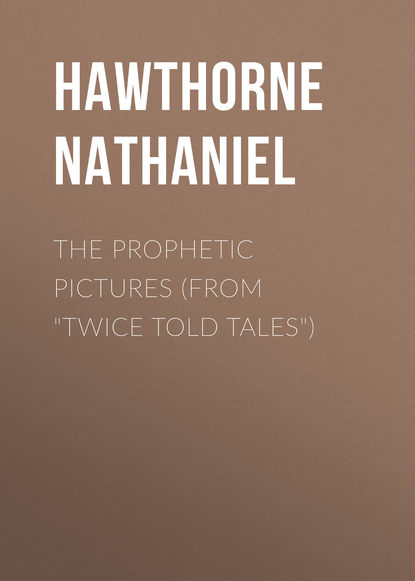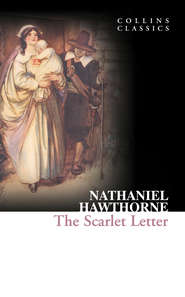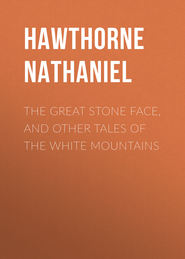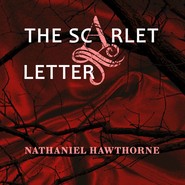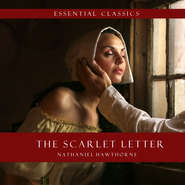По всем вопросам обращайтесь на: info@litportal.ru
(©) 2003-2024.
✖
The Prophetic Pictures (From "Twice Told Tales")
Настройки чтения
Размер шрифта
Высота строк
Поля
“In mine? – None!” replied Walter, examining it. “But let me see! Yes; there is a slight change, – an improvement, I think, in the picture, though none in the likeness. It has a livelier expression than yesterday, as if some bright thought were flashing from the eyes, and about to be uttered from the lips. Now that I have caught the look, it becomes very decided.”
While he was intent on these observations, Elinor turned to the painter. She regarded him with grief and awe, and felt that he repaid her with sympathy and commiseration, though wherefore she could but vaguely guess.
“That look!” whispered she, and shuddered. “How came it there?”
“Madam,” said the painter, sadly, taking her hand, and leading her apart, “in both these pictures, I have painted what I saw. The artist – the true artist – must look beneath the exterior. It is his gift – his proudest but often a melancholy one – to see the inmost soul, and by a power indefinable even to himself to make it glow or darken upon the canvas, in glances that express the thought and sentiment of years. Would that I might convince myself of error in the present instance!”
They had now approached the table, on which were heads in chalk, hands almost as expressive as ordinary faces, ivied church-towers, thatched cottages, old thunder-stricken trees, Oriental and antique costume, and all such picturesque vagaries of an artist’s idle moments. Turning them over, with seeming carelessness, a crayon sketch of two figures was disclosed.
“If I have failed,” continued he, “if your heart does not see itself reflected in your own portrait, if you have no secret cause to trust my delineation of the other, it is not yet too late to alter them. I might change the action of these figures too. But would it influence the event?”
He directed her notice to the sketch. A thrill ran through Elinor’s frame; a shriek was upon her lips; but she stifled it, with the self-command that becomes habitual to all, who hide thoughts of fear and anguish within their bosoms. Turning from the table, she perceived that Walter had advanced near enough to have seen the sketch, though she could not determine whether it had caught his eye.
“We will not have the pictures altered,” said she, hastily. “If mine is sad, I shall but look the gayer for the contrast.”
“Be it so,” answered the painter, bowing. “May your griefs be such fanciful ones, that only your picture may mourn for them! For your joys, – may they be true and deep, and paint themselves upon this lovely face till it quite belie my art!”
After the marriage of Walter and Elinor, the pictures formed the two most splendid ornaments of their abode. They hung side by side, separated by a narrow panel, appearing to eye each other constantly, yet always returning the gaze of the spectator. Travelled gentlemen, who professed a knowledge of such subjects, reckoned these among the most admirable specimens of modern portraiture; while common observers compared them with the originals, feature by feature, and were rapturous in praise of the likeness. But it was on a third class – neither travelled connoisseurs nor common observers, but people of natural sensibility – that the pictures wrought their strongest effect. Such persons might gaze carelessly at first, but, becoming interested, would return day after day, and study these painted faces like the pages of a mystic volume. Walter Ludlow’s portrait attracted their earliest notice. In the absence of himself and his bride, they sometimes disputed as to the expression which the painter had intended to throw upon the features; all agreeing that there was a look of earnest import, though no two explained it alike. There was less diversity of opinion in regard to Elinor’s picture. They differed, indeed, in their attempts to estimate the nature and depth of the gloom that dwelt upon her face, but agreed that it was gloom, and alien from the natural temperament of their youthful friend. A certain fanciful person announced, as the result of much scrutiny, that both these pictures were parts of one design, and that the melancholy strength of feeling, in Elinor’s countenance, bore reference to the more vivid emotion, or, as he termed it, the wild passion, in that of Walter. Though unskilled in the art, he even began a sketch, in which the action of the two figures was to correspond with their mutual expression.
It was whispered among friends, that, day by day, Elinor’s face was assuming a deeper shade of pensiveness, which threatened soon to render her too true a counterpart of her melancholy picture. Walter, on the other hand, instead of acquiring the vivid look which the painter had given him on the canvas, became reserved and downcast, with no outward flashes of emotion, however it might be smouldering within. In course of time, Elinor hung a gorgeous curtain of purple silk, wrought with flowers, and fringed with heavy golden tassels, before the pictures, under pretence that the dust would tarnish their lines, or the light din them. It was enough. Her visitors felt, that the massive folds of the silk must never be withdrawn, nor the portraits mentioned in her presence.
Time wore on; and the painter came again. He had been far enough to the north to see the silver cascade of the Crystal Hills, and to look over the vast round of cloud and forest, from the summit of New England’s loftiest mountain. But he did not profane that scene by the mockery of his art. He had also lain in a canoe on the bosom of Lake George, making his soul the mirror of its loveliness and grandeur, till not a picture in the Vatican was more vivid than his recollection. He had gone with the Indian hunters to Niagara, and there, again, had flung his hopeless pencil down the precipice, feeling that he could as soon paint the roar, as aught else that goes to make up the wondrous cataract. In truth, it was seldom his impulse to copy natural scenery, except as a framework for the delineations of the human form and face, instinct with thought, passion, or suffering. With store of such, his adventurous ramble had enriched him; the stern dignity of Indian chiefs; the dusky loveliness of Indian girls; the domestic life of wigwams; the stealthy march; the battle beneath gloomy pine-trees; the frontier fortress with its garrison; the anomaly of the old French partisan, bred in courts, but grown gray in shaggy deserts; – such were the scenes and portraits that he had sketched. The glow of perilous moments; flashes of wild feeling; struggles of fierce power; love, hate, grief, frenzy; in a word, all the worn-out heart of the old earth had been revealed to him under a new form. His portfolio was filled with graphic illustrations of the volume of his memory, which genius would transmute into its own substance, and imbue with immortality. He felt that the deep wisdom in his art, which he had sought so far, was found.
But, amid stern or lovely nature, in the perils of the forest, or its overwhelming peacefulness, still there had been two phantoms, the companions of his way. Like all other men around whom an engrossing purpose wreathes itself, he was insulated from the mass of human kind. He had no aim, – no pleasure, – no sympathies, – but what were ultimately connected with his art.
Though gentle in manner, and upright in intent and fiction, he did not possess kindly feelings; his heart was cold; no living creature could be brought near enough to keep him warm. For these two beings, however, he had felt, in its greatest intensity, the sort of interest which always allied him to the subjects of his pencil. He had pried into their souls with his keenest insight, and pictured the result upon their features, with his utmost skill, so as barely to fall short of that standard which no genius ever reached, his own severe conception. He had caught from the duskiness of the future – at least, so he fancied – a fearful secret, and had obscurely revealed it on the portraits. So much of himself – of his imagination and all other powers – had been lavished on the study of Walter and Elinor, that he almost regarded them as creations of his own, like the thousands with which he had peopled the realms of Picture. Therefore did they flit through the twilight of the woods, hover on the mist of waterfalls, look forth from the mirror of the lake, nor melt away in the noontide sun. They haunted his pictorial fancy, not as mockeries of life, nor pale goblins of the dead, but in the guise of portraits, each with the unalterable expression which his magic had evoked from the caverns of the soul. He could not recross the Atlantic, till he had again beheld the originals of those airy pictures.
“O glorious Art!” thus mused the enthusiastic painter, as he trod the street. “Thou art the image of the Creator’s own. The innumerable forms, that wander in nothingness, start into being at thy beck. The dead live again. Thou recallest them to their old scenes, and givest their gray shadows the lustre of a better life, at once earthly and immortal. Thou snatchest back the fleeting moments of History. With thee, there is no Past; for, at thy touch, all that is great becomes forever present; and illustrious men live through long ages, in the visible performance of the very deeds which made thorn what they are. O potent Art! as thou bringest the faintly revealed Past to stand in that narrow strip of sunlight, which we call Now, canst thou summon the shrouded Future to meet her there? Have I not achieved it? Am I not thy Prophet?”
Thus, with a proud, yet melancholy fervor, did he almost cry aloud, as he passed through the toilsome street, among people that knew not of his reveries, nor could understand nor care for them. It is not good for man to cherish a solitary ambition. Unless there be those around him, by whose example be may regulate himself, his thoughts, desires, and hopes will become extravagant, and he the semblance, perhaps the reality, of a madman. Reading other bosoms, with an acuteness almost preternatural, the painter failed to see the disorder of his own.
“And this should be the house,” said he, looking up and down the front, before he knocked. “Heaven help my brains! That picture! Methinks it will never vanish. Whether I look at the windows or the door, there it is framed within them, painted strongly, and glowing in the richest tints – the faces of the portraits – the figures and action of the sketch!”
He knocked.
“The Portraits! Are they within?” inquired he, of the domestic; then recollecting himself, – “your master and mistress! Are they at home?”
“They are, sir,” said the servant, adding, as he noticed that picturesque aspect of which the painter could never divest himself, “and the Portraits too!”
The guest was admitted into a parlor, communicating by a central door with an interior room of the same size. As the first apartment was empty, he passed to the entrance of the second, within which his eyes were greeted by those living personages, as well as their pictured representatives, who had long been the objects of so singular an interest. He involuntarily paused on the threshold.
They had not perceived his approach. Walter and Elinor were standing before the portraits, whence the former had just flung back the rich and voluminous folds of the silken curtain, holding its golden tassel with one hand, while the other grasped that of his bride. The pictures, concealed for months, gleamed forth again in undiminished splendor, appearing to throw a sombre light across the room, rather than to be disclosed by a borrowed radiance. That of Elinor had been almost prophetic. A pensiveness, and next a gentle sorrow, had successively dwelt upon her countenance, deepening, with the lapse of time, into a quiet anguish. A mixture of affright would now have made it the very expression of the portrait. Walter’s face was moody and dull, or animated only by fitful flashes, which left a heavier darkness for their momentary illumination. He looked from Elinor to her portrait, and thence to his own, in the contemplation of which he finally stood absorbed.
The painter seemed to hear the step of Destiny approaching behind him, on its progress towards its victims. A strange thought darted into his mind. Was not his own the form in which that destiny had embodied itself, and he a chief agent of the coming evil which he had foreshadowed?
Still, Walter remained silent before the picture, communing with it, as with his own heart, and abandoning himself to the spell of evil influence, that the painter had cast upon the features. Gradually his eyes kindled; while as Elinor watched the increasing wildness of his face, her own assumed a look of terror; and when at last he turned upon her, the resemblance of both to their portraits was complete.
“Our fate is upon us!” howled Walter. – “Die!”
Drawing a knife, he sustained her, as she was sinking to the ground, and aimed it at her bosom. In the action and in the look and attitude of each, the painter beheld the figures of his sketch. The picture, with all its tremendous coloring, was finished.
“Hold, madman!” cried he, sternly.
He had advanced from the door, and interposed himself between the wretched beings, with the same sense of power to regulate their destiny, as to alter a scene upon the canvas. He stood like a magician, controlling the phantoms which he had evoked.
“What!” muttered Walter Ludlow, as he relapsed from fierce excitement into silent gloom. “Does Fate impede its own decree?”
“Wretched lady!” said the painter. “Did I not warn you?”
“You did,” replied Elinor, calmly, as her terror gave place to the quiet grief which it had disturbed. “But – I loved him!”
Is there not a deep moral in the tale? Could the result of one, or all our deeds, be shadowed forth and set before us, some would call it Fate, and hurry onward, others be swept along by their passionate desires, and none be turned aside by the PROPHETIC PICTURES.





